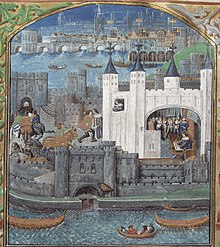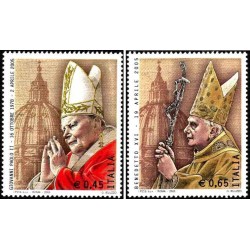- جدید
- ناموجود



France 1965 - The 500th Anniversary of The Death of Charles d´Orleans
توجه : درج کد پستی و شماره تلفن همراه و ثابت جهت ارسال مرسوله الزامیست .
توجه:حداقل ارزش بسته سفارش شده بدون هزینه پستی می بایست 100000 ریال باشد .
توجه : جهت برخورداری از مزایای در نظر گرفته شده برای مشتریان لطفا ثبت نام نمائید.
| Charles | |
|---|---|
 |
|
| Duke of Orléans | |
| Predecessor | Louis I |
| Successor | Louis II |
| Born | 24 November 1394 Paris, France |
| Died | 5 January 1465 (aged 70) Amboise |
| Burial | Saint Denis Basilica, France |
| Spouse | Isabella of Valois Bonne d'Armagnac Marie of Cleves |
| Issue | Joan, Duchess of Alençon Marie, Viscountess of Narbonne Louis XII of France Anne, Abbess of Fontevraud |
| House | House of Valois |
| Father | Louis I, Duke of Orléans |
| Mother | Valentina Visconti |

Charles of Orléans (24 November 1394 – 5 January 1465) was Duke of Orléans from 1407, following the murder of his father, Louis I, Duke of Orléans, on the orders of John the Fearless, Duke of Burgundy.[1] He was also Duke of Valois, Count of Beaumont-sur-Oise and of Blois, Lord of Coucy, and the inheritor of Asti in Italy via his mother Valentina Visconti, daughter of Gian Galeazzo Visconti, Duke of Milan.
He is now remembered as an accomplished medieval poet owing to the more than five hundred extant poems he produced, written in both French and English, during his 25 years spent as a prisoner of war.
Charles was born in Paris. Acceding to the duchy at the age of thirteen after his father had been assassinated, he was expected to carry on his father's leadership against the Burgundians, a French faction which supported the Duke of Burgundy. The latter was never punished for his role in Louis' assassination, and Charles had to watch as his grief-stricken mother Valentina Visconti succumbed to illness not long afterwards. At her deathbed, Charles and the other boys of the family were made to swear the traditional oath of vengeance for their father's murder.
During the early years of his reign as duke, the orphaned Charles was heavily influenced by the guidance of his father-in-law, Bernard VII, Count of Armagnac, for which reason Charles' faction came to be known as the "Armagnacs".
After war with the Kingdom of England was renewed in 1415, Charles was one of the many French noblemen at the Battle of Agincourt on October 25, 1415. He was discovered unwounded but trapped under a pile of corpses, incapacitated by the weight of his own armour.[2] He was taken prisoner by the English, and spent the next twenty-four years being moved from one castle to another in England, including Pontefract Castle the castle where England's king Richard II had been imprisoned and died.[3] The conditions of his confinement were not strict; he was allowed to live more or less in the manner to which he had become accustomed, like so many other captured nobles. However, he was not offered release in exchange for a ransom, since Henry V of England had left instructions forbidding any release: Charles was the natural head of the Armagnac faction and in the line of succession to the French throne, and was therefore deemed too important to be returned to circulation.
After his capture, his entire library was moved by Yolande of Aragon to Saumur, to prevent it from falling into enemy hands.
It was during these twenty-four years that Charles would write most of his poetry, including melancholy works which seem to be commenting on the captivity itself, such as En la forêt de longue attente.[4]
The majority of his output consists of two books, one in French and the other in English, in the ballade and rondeau fixed forms. Though once controversial, it is now abundantly clear that Charles wrote the English poems which he left behind when he was released in 1440.[5] Unfortunately, his acceptance in the English canon has been slow. A. E. B. Coldiron has argued that the problem relates to his "approach to the erotic, his use of puns, wordplay, and rhetorical devices, his formal complexity and experimentation, his stance or voice: all these place him well outside the fifteenth-century literary milieu in which he found himself in England."[6] In other words, his English poetry sits stylistically between the Middle Ages and the Renaissance.
One of his poems Is she not passing fair?, translated by Louisa Stuart Costello, was set to music by Edward Elgar. Claude Debussy set three of his poems to music in his Trois Chansons de Charles d'Orléans, L.92, for unaccompanied mixed choir.
Finally freed in 1440 by the efforts of his former enemies, Philip the Good and Isabella of Portugal, the Duke and Duchess of Burgundy, he set foot on French soil again after 25 years, "speaking better English than French", according to the English chronicler Raphael Holinshed. Philip the Good had made it a condition that the murder of Louis of Orleans by John the Fearless would not be avenged. (John himself had been assassinated in 1419.) Charles agreed to this condition prior to his release.[7] Meeting the Duchess of Burgundy after disembarking, the gallant Charles said: "M'Lady, I make myself your prisoner." At the celebration of his third marriage, with Marie of Cleves, he was created a Knight of the Golden Fleece. His subsequent return to Orléans was marked by a splendid celebration organized by the citizens.
He made a feeble attempt to press his claims to Asti in Italy, before settling down as a celebrated patron of the arts. He died at Amboise, aged 70.
Charles appears in Shakespeare's play Henry V as the "Duke of Orléans".
Charles married three times. His first wife Isabella of Valois (daughter of Charles VI of France and widow of Richard II of England), whom he married in Compiègne in 1406, died in childbirth.[8] Their daughter, Joan married John II of Alençon in 1424 in Blois.
Afterwards, he married Bonne of Armagnac,[8] the daughter of Bernard VII, Count of Armagnac, in 1410. Bonne died before he returned from captivity.
On his return to France in 1440, Charles married Marie of Cleves[8] in Saint-Omer (daughter of Adolph I, Duke of Cleves) and had three children:
تشکر نظر شما نمی تواند ارسال شود
گزارش کردن نظر
گزارش ارسال شد
گزارش شما نمی تواند ارسال شود
بررسی خود را بنویسید
نظر ارسال شد
نظر شما نمی تواند ارسال شود

France 1965 - The 500th Anniversary of The Death of Charles d´Orleans
check_circle
check_circle















